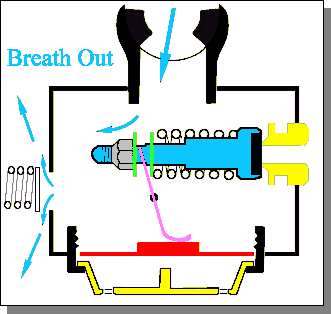Ah, ok, so we're on the same page after
all :-)
I thought you meant separate
valves, sensors, etc.
Rick L
----- Original Message -----From: AkinsSent: Friday, January 20, 2006 9:11 PMSubject: Re: [PSUBS-MAILIST] Ambient / 1ATM Q?Hi Rick.I wrote....."What all ambients have in common whether they have an opening to the water (like in an upside down glass) and use the rising water level to trip a float, valve or sensor which then activates their air tanks to vent, or whether they are closed to the water and use a valve or sensor, is that they use internal air pressure to push back against the external water pressure"You wrote...."A sealed cockpit obviates the need for a sensor of any kind since the regulators themselves do the job for you (hence, the term "regulator"). The demand regulator is a valve in itself. The rubber diaphram in front of the mouth piece physically pushes a lever that opens the valve".That's what I said Rick. "whether they are closed to the water and use a valve or sensor". The rubber diaphram in the reg IS the sensor and the valve in the regulator body IS the valve.Bill Akins.----- Original Message -----From: Rick and MarciaSent: Friday, January 20, 2006 3:23 AMSubject: Re: [PSUBS-MAILIST] Ambient / 1ATM Q?Hi, Patrick, Bill, et al . . .
I did not realize Rick and Joe were using constant air flow in their ambient designs. Now I see why their hull interiors are almost devoid of water vapour.Regarding constant flow: I'm not sure if Joe is intent on using constant flow in his sub or if he was using the term by way of explanation.My ambient will use a bank or manifold, if you will, of regulators. There will be no constant flow. The regs I'm talking about are standard scuba and are sometimes referred to as DEMAND regs (as opposed to CONSTANT FLOW). By only demanding air when you need it you save your supply.As Rick pointed out earlier this can be handled by dessicant absorbant which is a powder which absorbs water.and basically wicks water out of the air. The air in their tanks is much dryer than normal air also so this helps too.I've used the term "bone-dry" in previous posts and, as Bill has pointed out, there really is little likelihood of anything being bone-dry in a sub cabin. I spoke in relative terms. Desert air is considered "bone-dry" yet actually contains a significant amount of water vapour. Just ask anyone who's had to do a miliary survival course.Magiacl Child's system will be similar to using Barolyme to absorb CO2. Initially I had intended on venting our (breath) exhalations directly from our oral/nasal masks to the surrounding water. I've since experienced an epiphany and am now thinking of simply exhaling straight into the cabin. In this scenario, the dessicant would simply absorb the water vapour from the cabin air (but wouldn't purify it). The cabin's overpressure valve would occasionally burp the excess pressure to the surrounding water.The down side, of course, is that the cabin air would be perennially stale and would support us for less time should we need to stop using our masks. Exhaled CO2 still contains a lot of O2 since the body doesn't metabolise all the oxygen. So, there is still some breathing room so to speak. Mind you, that's what pony bottles are for.What all ambients have in common whether they have an opening to the water (like in an upside down glass) and use the rising water level to trip a float, valve or sensor which then activates their air tanks to vent, or whether they are closed to the water and use a valve or sensor, is that they use internal air pressure to push back against the external water pressureA sealed cockpit obviates the need for a sensor of any kind since the regulators themselves do the job for you (hence, the term "regulator"). The demand regulator is a valve in itself. The rubber diaphram in front of the mouth piece physically pushes a lever that opens the valve.I'd like to add to this by saying that a semi-dry ambient can also use this system. How? Once the required amount of ballast water is admitted, you seal off the cockpit so that the regs take over. Open the valve, the cabin is exposed to surrounding water and the regs are disabled by default. Close the valve, and the cabin pressure is now isolated and available to the regs.Confused yet?Rick L
